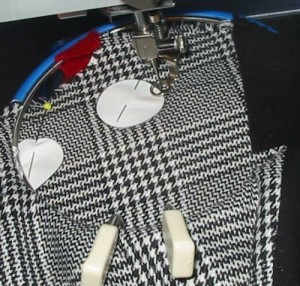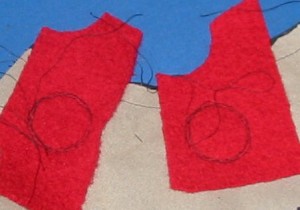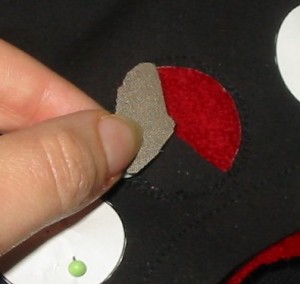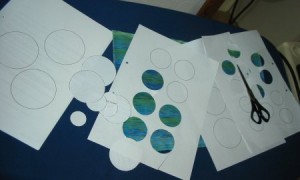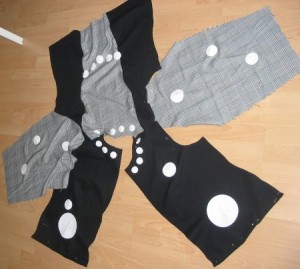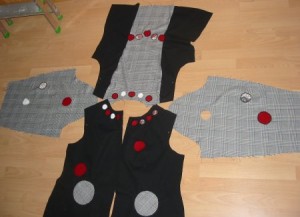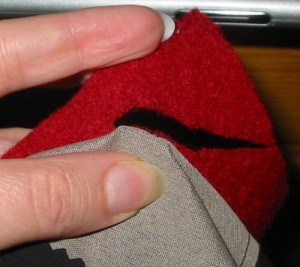 Nachdem ich gestern auf einem gemütlichen Mininähtreffen bei Silvia in Aachen war (fünf Leute passen gerade perfekt um den Nähtisch… *g*) geht es erst heute mit der Applikation weiter. (Was ich bei dem Treffen genäht habe kommt auch noch… irgendwann später. Ein paar Handstiche sind noch nötig.)
Nachdem ich gestern auf einem gemütlichen Mininähtreffen bei Silvia in Aachen war (fünf Leute passen gerade perfekt um den Nähtisch… *g*) geht es erst heute mit der Applikation weiter. (Was ich bei dem Treffen genäht habe kommt auch noch… irgendwann später. Ein paar Handstiche sind noch nötig.)
Oben ist aufgeschnitten, jetzt muß natürlich auch unten der überstehende Stoff weg.
Hier benutze ich meine große Nähschere. Ich halte das Werkstück ziemlich genau wie das Bild zeigt, die Jacke liegt in meinem Schoß und mit zwei Fingern der linken Hand spanne ich den Applikationsstoff etwas.
Dann kann ich knapp an den Stichen schneiden, ohne unbeabsichtigt in etwas anderes hineinzuschneiden. Und wenn ich den gespannten Stoff loslasse, zieht er sich noch näher an die Stichreihen zurück.
Yesterday we had a very relaxed and productive (I finished something, except some hand-stitches. I hope to finde the time to show it that week…) sewing-meeting at Silvias shop in Aachen. (Five is the perfect number to fit the table…) So my explications about the negative applique had to wait for today.
Okay, the main fabric has been cut out, next thing is to cat away the „seam allowances“ of the applique-fabric.
Again I’m using my big, sharp scissors. (BTW… shears, scissors… I never know what to use… anybody who can explain what applies when?) The picture shows quite well how I’m holding the fabric while cutting. The jacket rests in my lap and two fingers of my left hand hold the applique-fabric taunt.
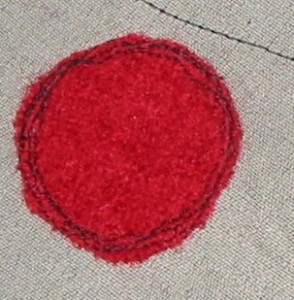 So I can cut close to the stitches, avoiding to cut at unwanted places and when I release the red fabric it retracts a bit and comes again a little closer to the stitching.
So I can cut close to the stitches, avoiding to cut at unwanted places and when I release the red fabric it retracts a bit and comes again a little closer to the stitching.
So that is what it looks like from the back after beeing cut back.
Und so sieht das ganze von der Rückseite aus, nachdem der Stoff zurückgeschnitten ist.
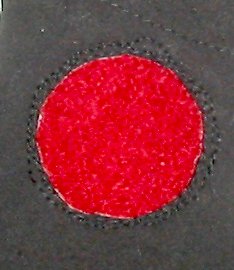 Und so sieht die Applikation von der rechten Seite aus.
Und so sieht die Applikation von der rechten Seite aus.
Man sieht (trotz Bearbeitung in gimp), daß schwarze Stiche auf schwarzen Stoff kaum zu sehen sind.
Wenn der Oberstoff nicht sehr ausfranst könnte man die Applikation jetzt sogar so lassen, man hätte dann eine offenkantige Applikation. Allerdings hätte ich mir in dem Fall mit den Steppstichreihen etwas mehr Mühe geben müssen…
And that’s the right side view.
Even after some work with gimp you see, that black stitches in black fabric are not very well do see…
If you have a fabric that does not ravel much, you can finish here. (And if you like the look of a raw edge applique, of course.) In this case, of course, I would have worked the rows of stitching with a little (lot) more care…
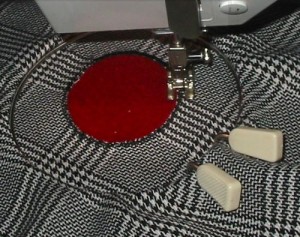 So my application gets a satin stitched border, as a „traditional“ applique would get, too.
So my application gets a satin stitched border, as a „traditional“ applique would get, too.
In case you may wonder… yes, I’m using a hoop together with a „normal“ pressure foot and the feed dogs working. There is no law against that… :o) The Prince de Gaulle fabric had a strong tendency to stretch under the pressure foot. I didn’t want to use tear-away stabilizer, because that leaves a bit of residue under the satin stitches, and didn’t want to use water soluble stabilizer (e.g. Soluvlies) because I didn’t want to wash the jacket before the presentation. Neither had I wanted to use iron on stabiliser, because I wanted the fabric to remain soft without influencing the drape…
If all that is the case… hooping is the perfect solution. (And if you are sewing circles it becomes even easier to guide the fabric with the round hoop…)
To become a close border without building to much stitches I had to sew over the border twice. The first round I used my usual satinstitch length plus two units on my sewing machine. The second round was in normal stitch lengths for satin stitch. For a shiney and smooth appearance ‚ve used embroidery thread, Gütermann-Sulky it was.
Da ich keine offenkantige Applikation wollte, bekamen meine Kreise als Randabschluß einen ganz normalen Satinstich (auch Raupenstich oder Knopflochstich genannt).
Und, ja, man kann einen normalen Nähfuß und den Transporteur mit einem Stickrahmen zusammen benutzen. Mein Problem war, daß der Karostoff und die gekochte Wolle beide sehr weich sind und daher beim übernähen mit dem dichten Satinstich eine deutliche Neigung zur Wellenbildung hatten. Stabilisieren wollte ich nicht. Aufgebügelte Vlieseline hätte den Stoff an der Stelle etwas steifer gemacht, was ich nicht wollte. Stickvlies zum Abreißen bleibt unter Satinstichen auch immer etwas drin. Oder/und ist unendlich mühsam rauszupopeln. Wollte ich auch nicht. Und Soluvlies zu verwenden hätte bedeutet, daß ich die Jacke vor der Challengevorführung noch mal hätte waschen müssen. Wollte ich auch nicht.
Also war der Stickring die perfekte Lösung. (Mit dem netten Nebeneffekt, daß man den Stoff dank des runden Stickrings sogar leichter kreisförmig führen kann….)
Um eine glatten Kante zu bekommen, brauchte ich in diesem Fall zwei Runden Satinstich übereinander. Damit es nicht zu dick wird, habe ich für die erste Runde die Stichlänge zwei Einheiten länger gestellt als für den normalen Satinstich. Das hielt die kleinen Faserchen des fransenden Glenchecks ganz gut im Zaum. Und dann noch eine Runde normal enger Satinstich, für das glatte Finisch. Deswegen auch Stickgarn dafür. Gütermann-Sulky in diesem Fall.
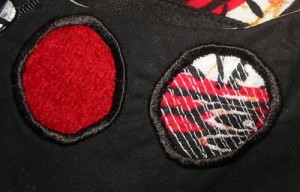 Und so sieht die negative Applikation fertig aus. (Nein, nicht perfekt rund, aber rund genug…. 😉
Und so sieht die negative Applikation fertig aus. (Nein, nicht perfekt rund, aber rund genug…. 😉
Stellt sich vielleicht die Frage: warum eigentlich „negativ“ applizieren?
Ein Vorteil ist, daß man nur eine Stoffschicht hat, die Applikation ist also dünner und weicher, je nach Stoff wirkt sich das natürlich unterschiedlich aus.
Der zweite Grund war, daß ich den afrikanischen Stoff (rechts auf dem zweiten Bild) durch die Biesen etwas gerippt hatte. Diese Rippen wären durch die Satinstiche nicht gut glatt zu bekommen, der Rand wäre beim aufapplizieren also immer ungleichmäßig geblieben.
Und das dritte Anwendungsgebiet (was hier keine Rolle spielte) ist, daß man damit ein Loch bearbeite kann, ohne es vorher stopfen zu müssen. 😉
Vielleicht hat ja jemand Lust bekommen, es auch einmal mit einer negativen Applikation zu versuchen?
The last picture shows the finished circles. No, they are not perfect circles, but good enough to be circles.
Remains the question, of course, why one should do reverse appliques?
One advantage is, that they remain softer, influence the drape of the fabric less than a „normal“ applique. How strong the effect is depends on the fabric and the garment, of course.
Another reason to use that technique was, that I had created a kind of „ribbing“ on the african print fabric. If you try to make satin stitch over such a structure you will find out, that the stitches cannont „press“ the ribbing flat, therefore will not lie smooth and flat.
And a third reason (in general, not for me in this case) is you can repair holes without having to mend them first… 😉
Maybe now you are motivated, to try a negative applique, too?

